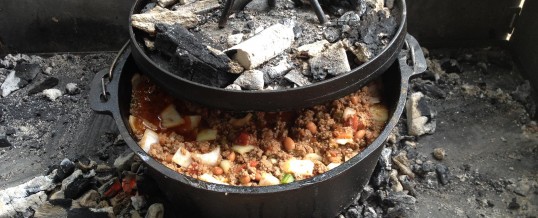
A number of years ago, I stumbled across a television program on what was then a new cable offering called the RFD-TV channel. A man named Cee Dub was on the screen cooking an entire meal using only Dutch ovens. I was fascinated.
I vaguely remembered these cast iron pots with three legs from my days in the Scouts. I made it through Cub Scouts and Webelos, but only a year or so of Boy Scouts. By about age 12, I left the Boy Scouts for sports and other endeavors.
I suspect that the use of Dutch ovens and fire probably was entrusted more to the older boys, which, with my departure from the Boy Scouts of America, would explain my lack of familiarity with the use of these historic and still viable cooking vessels.
Back to Cee Dub. I set the DVR to record his upcoming shows. As I watched more episodes, I learned that he was a retired game warden from the State of Idaho who had parlayed his assignment as camp cook during his working years into a television program, cookbooks, and weekend camp retreats, to teach others how to cook the way of the American pioneers and cowboys.
What fascinated me about Dutch oven cooking was that anything you can cook in a regular oven can be cooked in a Dutch oven. You can also boil or fry food in them.
From a pot roast, to a chicken, to a casserole, to a peach cobbler, to biscuits, if you follow the right heat formula above and beneath your pot, you can cook a gourmet meal in the woods or on your back porch.
A little history about Dutch ovens. My search to find out why they’re named what they are led to no definitive answer. Some believe that it has to do with the Dutch figuring out a better manufacturing process for the ovens. Others believe they got their name from the Dutch settlers in America. No one seems to know for sure.
One thing that isn’t in doubt is the versatility and value these pots have possessed through the years. One story tells of George Washington’s mother leaving half of what was referred to as her “iron kitchen furniture” to a grandson, and the other half to a granddaughter. That was in 1788.
The early settlers in this country relied on Dutch ovens for cooking virtually every meal. The cast iron evenly distributed heat, and the lids provided a way to add the right amount of warmth to the top of what was being cooked.
As the country expanded west, cowboys and chuckwagon cooks relied on Dutch ovens for the long rides and keeping cowpokes fed.
Most of the Dutch ovens that are popular today are similar to what the cowboys used. They’re referred to as “cowboy,” “chuckwagon,” or “camp” Dutch ovens. They have three short legs, and a lid with a lip around it.
Since heat rises, you need fewer hot coals under the oven than you do on the top. The art of cooking with these ovens is knowing how many coals to keep underneath and on top. Factors such as size of the coals and wind can cause temp spikes. Ignoring your coals can cause temp drops. You really do have to practice.
One of the best litmus tests for the progress you’re making on the dish your cooking is something that Cee Dub often says on his show. “If it smells done, it’s done. If it smells burnt, it’s burnt.”
He’s right.
My first foray into giving this type of cooking a shot was using a Lodge 10-inch Dutch oven my friend George gave me. He surprised me with this gift after I mentioned I’d been watching the TV show and was going to give this new hobby a try. Lodge and Camp Chef are the primary manufactures of the better ovens. Cheaper ones are available, but I wouldn’t recommend them.
I kept my first dish simple. It was a can of Pillsbury Flaky Biscuits. I used charcoal briquettes and the biscuits came out great.
From there, I’ve added larger ovens to my collection and cooked roasts, vegetables, and desserts. You can also stack Dutch ovens, with the largest on the bottom to the smallest one on the top. This allows you to utilize all of the heat to its maximum potential.
Truly, anything you can cook in the oven in your house, you can cook in a Dutch oven.
I’ve also discovered another heat source for Dutch ovens instead of fire and coals. A solar oven.
Solar ovens are simple. They’re a box with four reflecting panels that direct the sun’s rays into the box chamber. You can place a smaller Dutch oven inside the solar oven and use the free energy to cook your meal.
Both Dutch and solar ovens are a lot of fun, especially for children, who often have little idea how food is cooked. Exposing kids, or even adults, to this type of outdoor cooking often turns into a fun hobby between friends. There are many groups who spend time camping and having friendly cooking competitions. Roaming from campsite to campsite and sampling the different dishes is common.
Not only is cooking outdoors fun, it is also a good backup way that you can prepare food during a power outage or disaster.
After I finish writing this, I plan on making some baked potatoes in one of my prized three-legged, cast iron vessels. My wife is out of town at the moment and a buddy of mine is coming over. For this lunch, we’re going Dutch.
©2017 John Moore
To read additional blogs, visit johnmoore.net/blog
APR
2017
